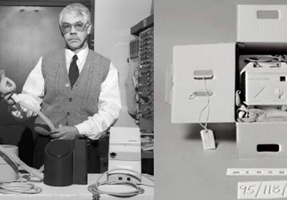
1980 – CPAP had humble beginnings. It all started when a man used a vacuum cleaner to treat his dog’s breathing problems. Soon after, it became clear that this would benefit humans and testing began. Colin Sullivan, inventor of the CPAP, saw amazing results in a few short hours of testing and he knew this was going to make a big difference in people’s lives.
” I went through a series of cycles increasing the pressure…literally “turning off” the apnea, and then dropping the pressure and “turning on” the apnea. There was no uncertainty or ambiguity. The method worked. The effect was so clear and repeatable, the next question to answer was would it work all night”
1981 – The CPAP machine was invented. Now patients did not need to be in a lab to get treatment. There was a machine they could take home. There early machines were bulky and masks were affixed with an adhesive. Aren’t you glad times have changed?
1985 – CPAPs are now widely available to Americans. The appropriately name Sullivan CPAP by ResMed is pictured above. Click here to view modern models.
1990 – Fisher and Paykel introduce the first passover humidifier. The water was not heated in early models. The pressurized air simply blew over the water to add moisture. This advancement in CPAP tech increased patient comfort significantly. Most patients today use a humidifier and many say they couldn’t live without one.
1994 – The Mirage Swift was the first nasal pillow mask and paved the way for minimal and comfortable new masks like the AirFit P10.
1995 – In ’95 humidifiers were revamped. They became part of the CPAP machine to reduce the size and made the second tube to attach the machine to the humidifier obsolete. At the same time, the humidifiers became heated so the water would evaporate and increase moisture levels. Anyone who has ever had a dry nose and throat after a night of CPAP therapy can see why this was a big deal.
2007 – Now, for the biggest advancement since the CPAP itself. Drum roll please…the auto-titrating CPAP! This machine can detect what pressure setting you need and set to that pressure, ensuring the most comfortable therapy at all times. Did you know your pressure needs can change on a daily or even an hourly basis? Learn more.
2011 – Have you ever had water dripping into your mask from your tube? Well then you need a Climate Line . The tube itself is heated and it prevents water from condensing in the tube.
2014 – The AirSense CPAPs are the first CPAPs with a built in cellular modem allowing you to track your therapy like never before and get your machine adjusted without leaving the house.
1. Sullivan, Colin. “Past, Present and Future of CPAP.” National Sleep Foundation. N.p., n.d. Web. 10 Feb. 2015.










